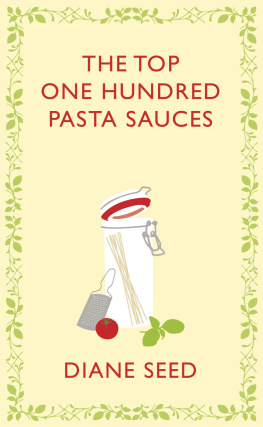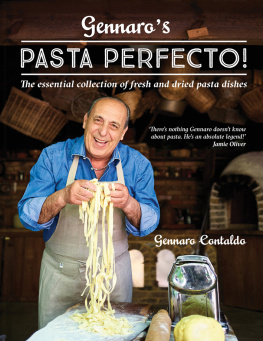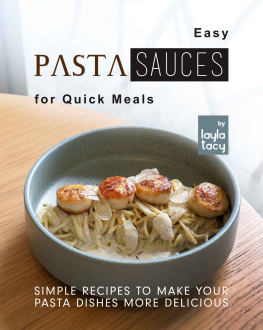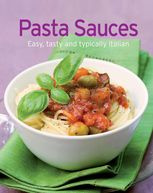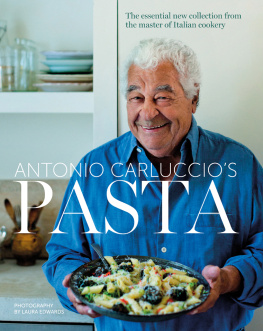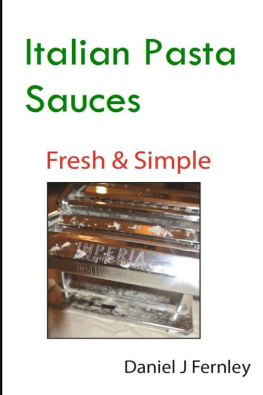Contents
About the Book
The scent of torn basil leaves; the sizzle of pan-fried prawns; the sight of an olive-studded Spaghetti alla Puttanesca and the earthy flavour of a Tagliatelle al Tartufo: pasta sauces invigorate all the senses.
Trusted by cooks for over 25 years, Diane Seed shares the one hundred best sauce recipes she has encountered in 40 years of living, loving, eating and cooking in Italy. Infinitely varied, it features specialities from regions across Italy including Sardinian Pasta with Lamb Sauce, and classics like Spaghetti alle Vongole, that are both delicious and economical. Plus there are some extra-special dishes such as the intricately moulded Bucatini alla Flamande that are perfect for occasions.
This charming, fully revised and definitive collection of recipes is as wide-ranging as Italian culture itself. With flavours bursting from the simplest ingredients, its authentic Italian pasta dishes will elevate home cooking to the truly sensational.
About the Author
Diane Seed has lived in Rome for 40 years and has built up an international reputation for her unrivalled knowledge of Italian regional cuisine. Her first cook book, Top One Hundred Pasta Sauces, sold over a million copies and was translated into 12 languages. Diane writes for various magazines and travels the world giving lectures, lessons and demonstrations. She worked frequently for the International Olive Oil Council, and for eight years as the Italian food consultant for Marks and Spencer in the UK.
Also by Diane Seed
Eating out in Italy
The Top One Hundred Italian Dishes
More Great Italian Pasta
Favourite Indian Food
Diane Seeds Mediterranean Dishes
Italian Cooking with Olive Oil
Diane Seeds Roman Kitchen or Rome for all Seasons
The Top 100 Italian Rice Dishes
Love food, Love Rome or The Food Lovers Guide to the Secrets of Gourmet Rome
For Antonio, who first taught me to appreciate good pasta
Introduction
Pasta has always been the glory of Italian food, and a symbol of Italian national pride. Today, Italian pasta, like Italian fashion, delights the world.
Nutritionists daily publish new support for the Mediterranean diet as the healthiest and most natural food for us all, low in fat, moderate in protein, high in vitamins and carbohydrates. And that diet is founded on vegetables, fish, and pasta. Pasta itself is not fattening, though some sauces inspire caution. Cooks of many nationalities, whether offering unusual dishes for demanding friends, attempting to fill hungry families, or needing something fast after the office, frequently find they can solve their menu problems by turning to pasta. Pasta dishes are infinitely varied: delicious, usually economical, largely vegetarian, can be fast and simple or complicated and extravagant according to mood.
Perhaps the one strength of which the non-Italian pasta cook is unaware is this variety. Even quite expert cooks often know only half a dozen pasta sauces. Yet the different regions of Italy yield many local specialities and numerous variations on national themes that have been tried and tested over generations. The fresh green vegetable sauces of Puglia in the southern heel of Italy, the rich pork and tomato rag of Naples, the delicate saffron and courgette-flower confection of the Abruzzi region, the aubergine recipes of Sicily, and the lemon sauces of the Amalfi coast all contribute to the amazing versatility of pasta as the foundation of innumerable meals. In the areas around Milan and Venice, traditionally dominated by rice, new pasta sauces are making increasing inroads. Italians eat pasta every day and they are not a people amused by monotony. Pasta has to appear in many guises to continue to arouse applause.
In this book, I have drawn together one hundred of the best pasta sauce recipes, encountered after many years of living, eating and cooking in Italy. Many of them are simple sauces that can be cooked in a few minutes. Others are elaborate confections from the kitchens of great Italian families. All of them adapt well to the needs of other countries, and other climates. However, it would be as well to remember that in Italy pasta is served as an entre dish before the meat course, while outside Italy it is frequently thought of as the main course itself, and served with simply a salad to follow. In allowing for this, I have recommended quantities for all the pasta variations to feed four to six: an ample dinner for four hungry people, or sufficient for six elegant diners who will then move on to a main course, as in Italy.
How to serve pasta in the Italian style
Although pasta dishes are now eaten with equal enthusiasm from California to Australia, outside Italy they often do not taste as good as they could. But with time, and the knowledge of the following basic rules, we can all learn to perfect our pasta.
Top quality pasta
First and foremost, Italians make sure that the pasta itself takes priority and they know that no sauce, no matter how exquisite, will make the dish come right if the pasta itself is second-rate. This means buying good pasta to start with, from a reliable manufacturer of dried pasta or a high quality specialist shop making its own fresh pasta. If in doubt, I would always choose good quality dried pasta rather than doubtful or even stale fresh pasta. The best durum wheat pasta is pressed through bronze dies. The metal is not completely smooth so the extruded pasta has a rough surface that attracts the sauce. Look for bronze die on the packet. De Cecco, available worldwide, is popular throughtout Italy and use bronze dies. Another good pasta is Voiello but this is no longer exported. Pasta produced with teflon dies is too smooth and in many cases it repels the sauce. The pasta produced in Gragnano, in the province of Naples, is excellent although less widely distributed outside Italy.
A pan for pasta
A very large, tall, good quality pan in which to boil sufficient water for the pasta is also a necessity: every 500g/1lb of pasta needs to be cooked in at least 4 litres/7 pints of water and about 2 tablespoons of salt. Bring the water to the boil and add the salt. With the water boiling briskly add all the pasta at the same time. Long pasta should be eased in and never broken. Stir the pasta every so often with a wooden fork to ensure that it stays separate. Bring the pasta and water back to the boil and boil briskly in an uncovered pan. In Italy we always use coarse sea salt to cook pasta. In my early years in Rome I asked why and the usual answer from everyone, including chefs, was because you do. When I used fine salt on my return visits to London I found it very difficult to get the correct level of salt. Over the years I have come to the conclusion that as coarse salt takes longer to dissolve, the pasta absorbs the salt gradually.
Timing: the essential skill
Italians fuss over perfectly cooked pasta as the French over a souffl or the English over well-made tea. Pasta should always be firm and provide some resistance or bite, as the Italians say, al dente. The old Neopolitan description was vierdi or green as in slightly unripened fruit. Pasta, after all, is largely a texture.
In Italy no one dreams of adding the pasta to the boiling water until those who are going to eat it are actually present. Restaurants cook pasta freshly for every customer and do not understand impatient tourists who fret about the delay at the start of the meal. Instant pasta invariably means bad pasta, so everyone should be prepared to wait for it to be freshly cooked. The golden rule is the sauce waits for the pasta. The water is ready boiling but the pasta is never thrown in until the sauce is ready. Pasta baked in the oven is the only kind that can be prepared in advance, which makes a dish like Baked Pasta and Artichokes () ideal for formal entertaining.
Next page
